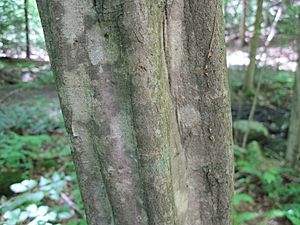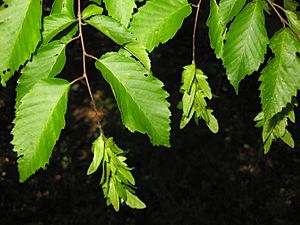American hornbeam facts for kids
Quick facts for kids American hornbeam |
|
|---|---|
 |
|
| Conservation status | |
| Scientific classification | |
| Genus: |
Carpinus
|
| Species: |
caroliniana
|
 |
|
| Natural range of C. caroliniana | |
| Synonyms | |
|
|
The American hornbeam (scientific name: Carpinus caroliniana) is a small, tough tree. It is also known by other cool names like blue-beech and musclewood. You can find this tree growing naturally across eastern North America. It stretches from Minnesota and southern Ontario in the north, all the way down to eastern Texas and northern Florida. It also grows in parts of Canada, specifically southwest Quebec and southeast Ontario.
Contents
What Does It Look Like?
The American hornbeam is usually a small tree. It typically grows to be about 10 to 15 meters (33 to 49 feet) tall. Sometimes, it can reach 20 meters (66 feet). Its trunk often looks wavy or "fluted," like a muscle, which is why it's sometimes called "musclewood."
The bark is smooth and greenish-grey when the tree is young. As the tree gets older, the bark develops shallow cracks.
- Leaves: The leaves grow one after another along the branch. They are about 3 to 12 centimeters (1 to 4.5 inches) long. They have clear veins that make them look crinkled or "corrugated." The edges of the leaves are jagged, like a saw. In autumn, the leaves turn bright red, deep scarlet, and orange.
- Flowers: In spring, at the same time the leaves appear, the tree grows male and female flowers. These flowers are called catkins. They look like long, hanging clusters.
- Fruit: The fruit is a tiny nut, about 7 to 8 millimeters (0.3 inches) long. It is partly covered by a leafy wrapper called an involucre. This wrapper is about 2 to 3 centimeters (0.8 to 1.2 inches) long. The nuts ripen in the autumn. Interestingly, the seeds often don't sprout until the spring of the second year after they ripen.
- Wood: The wood of the American hornbeam is light brown. The inner part of the wood, called sapwood, is almost white. It is very heavy, hard, and strong. This makes it useful for many things.
Different Types
There are two main types, or subspecies, of American hornbeam. They mix together a lot where their growing areas meet.
- Carpinus caroliniana subsp. caroliniana: This type is found along the Atlantic coastal plain up to Delaware. It also grows in the lower Mississippi Valley west to eastern Texas. Its leaves are usually smaller, about 3 to 9 centimeters (1 to 3.5 inches) long, and wider.
- Carpinus caroliniana subsp. virginiana: This type grows in the Appalachian Mountains and west to Minnesota. It also goes south to Arkansas. Its leaves are usually larger, about 8 to 12 centimeters (3 to 4.5 inches) long, and narrower.
Where Does It Grow and Live?
American hornbeam trees like shady spots. They prefer soil that is moderately rich in nutrients and has enough moisture. They have roots that spread out wide but don't go very deep.
You often find these trees along the edges of streams and swamps. They really love deep, moist soil.
Many animals use the American hornbeam. For example, the caterpillars of some moths, like the Io moth, eat its leaves. Deer also munch on the leaves and small branches. Game birds enjoy eating the small nuts.
What Is It Used For?
Because its wood is so heavy and hard, the American hornbeam is used for many things. People use it to make tool handles, longbows, walking sticks, and even golf clubs.
See also
 In Spanish: Carpinus caroliniana para niños
In Spanish: Carpinus caroliniana para niños




